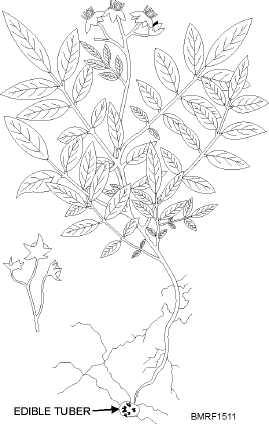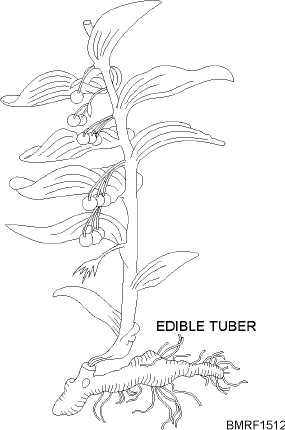15-20
Student Notes:
FOOD
CHARACTERISTICS
Wild potato
The wild potato is an example of an edible tuber (fig. 15-11). This small plant is found throughout
the world, especially in the tropics.
Solomon’s seal
Tubers of Solomon’s seal (fig. 15-12) grow on small plants found in North America, Europe,
Northern Asia, and Jamaica. Boiled or roasted, they taste much like parsnips.
Water chestnut
The water chestnut is a native of Asia, but it has spread to both tropical and temperate areas of the
world including North America, Africa, and Australia. It is found as a free-floating plant on rivers,
lakes, and ponds in quiet water. The plant covers large areas wherever it grows. It has two kinds of
leaves—the submerged leaf, which is long, rootlike, and feathery, and the floating leaf, which forms a
rosette on the surface of the water. Beneath the water, the plant bears nuts that are 1 to 2 inches broad
with strong spines that give them the appearance of a horned steer (fig. 15-13). You can roast or boil the
seed inside the horny structure.
Nut grass
Nut grass is widespread in many parts of the world. Look for it in moist, sandy places along the
margins of streams, ponds, and ditches. It occurs in both tropical and temperate climates. The grass
differs from true grass because it has a three-angle stem and thick underground tubers that grow ½ to 1
inch in diameter. (See fig. 15-14.) These tubers are sweet and nutty. Boil, peel, and grind them into
flour; you can use the flour as a coffee substitute.
Bullrush
Bullrush is a tall plant found in the wet, swampy areas of North America, Africa, Australia, the
East Indies, and Malaya. (See fig. 15-15.) You may eat the roots and white stem base cooked or raw.
Figure 15-11.—Wild potato.
Figure 15-12.—Solomon’s seal.




